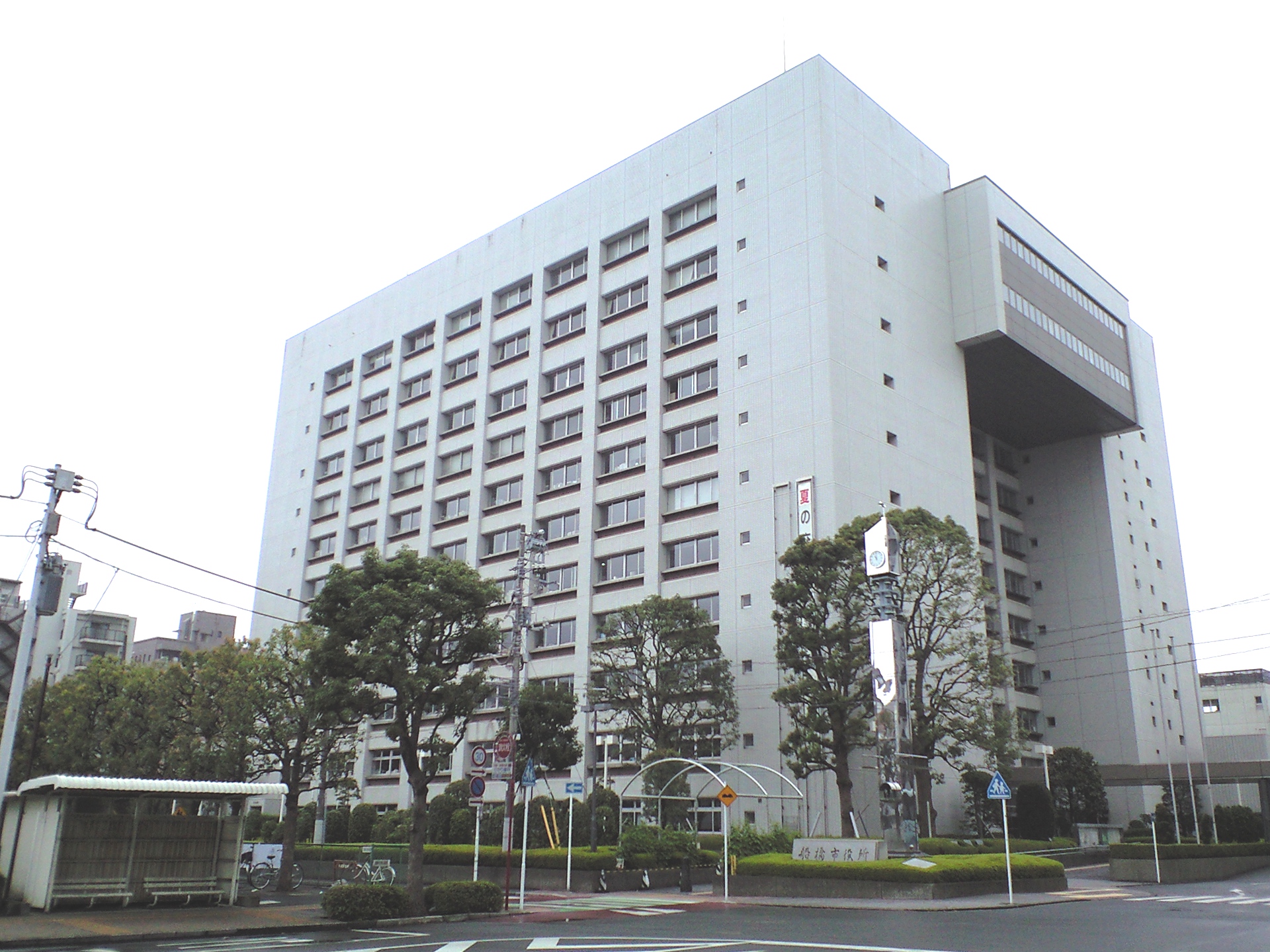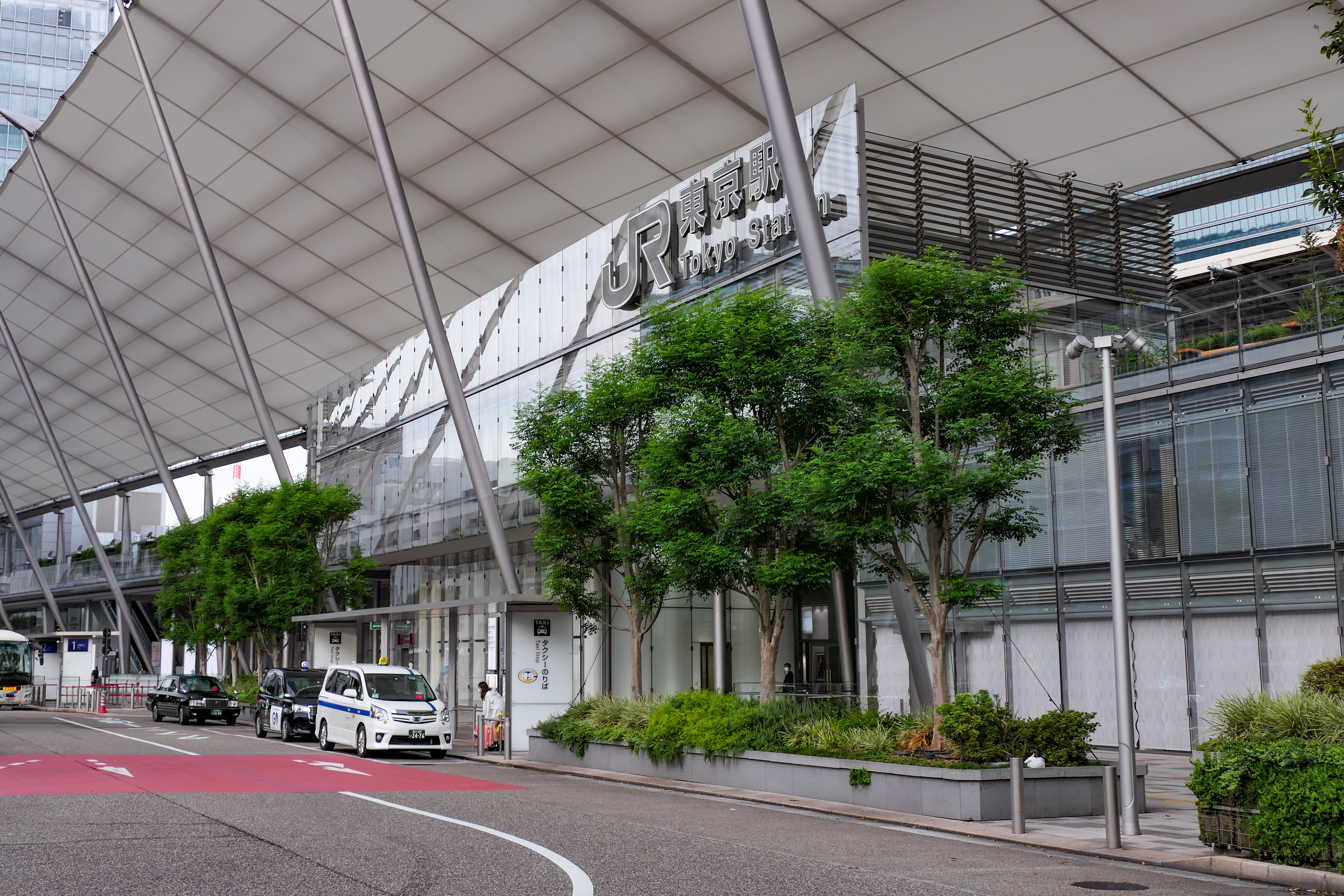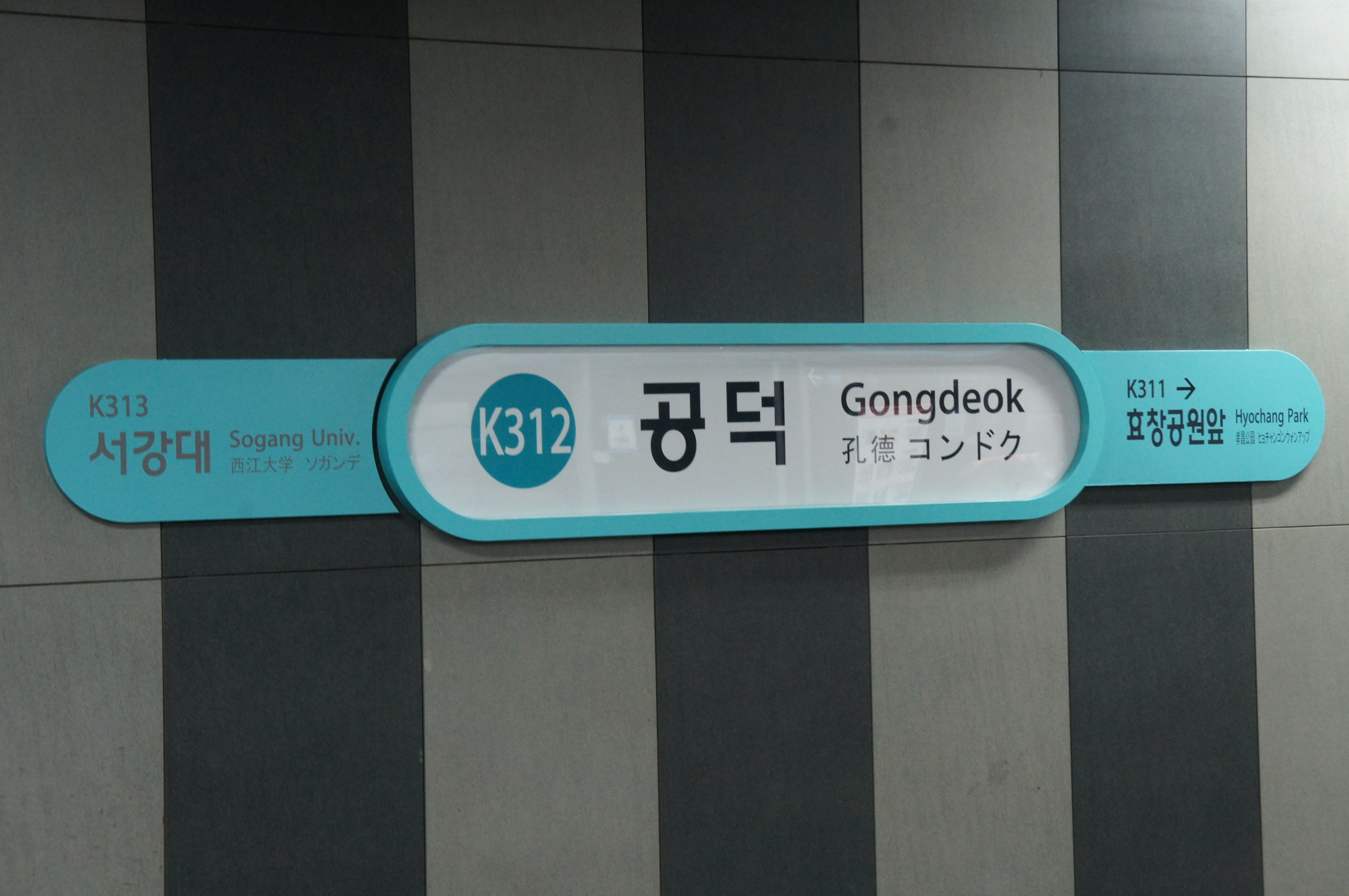|
Minami-Funabashi Station
is a passenger railway station in the city of Funabashi, Chiba, Japan, operated by East Japan Railway Company (JR East). Lines Minami-Funabashi Station is served by the Keiyō Line from and also by the orbital Musashino Line from via . It is 26.0 kilometers from Tokyo Station. Station layout The elevated station consists of two island platforms serving four tracks. The two centre tracks are used by terminating Musashino Line services. The station is staffed. Platforms File:JREast-Minami-funabashi-station-platform.jpg, View of the platforms looking westward, June 2008 File:Minami-Funabashi 20110514.JPG, View looking west, showing the terminating centre (Musashino Line) tracks, May 2011 File:JR Minami Funabashi Station - June 22 2019.jpeg, Entrance below the tracks, June 2019 History The station opened on 3 March 1986. Station numbering was introduced in 2016 with Minami-Funabashi being assigned station number JE11. Passenger statistics In fiscal 2019, the station w ... [...More Info...] [...Related Items...] OR: [Wikipedia] [Google] [Baidu] |
JR East
The is a major passenger railway company in Japan and is the largest of the seven Japan Railways Group companies. The company name is officially abbreviated as JR-EAST or JR East in English, and as in Japanese. The company's headquarters are in Yoyogi, Shibuya, Tokyo, and next to the Shinjuku Station. It is listed in the Tokyo Stock Exchange (it formerly had secondary listings in the Nagoya and Osaka stock exchanges), is a constituent of the TOPIX Large70 index, and is also one of the three only Japan Railways Group constituents of the Nikkei 225 index, the other being JR Central and JR West. History JR East was incorporated on 1 April 1987 after being spun off from the government-run Japanese National Railways (JNR). The spin-off was nominally "privatization", as the company was actually a wholly owned subsidiary of the government-owned JNR Settlement Corporation for several years, and was not completely sold to the public until 2002. Following the breakup, ... [...More Info...] [...Related Items...] OR: [Wikipedia] [Google] [Baidu] |
Keiyō Line
The is a railway line connecting Tokyo and Chiba in Japan, paralleling the edge of Tokyo Bay. It is operated by the East Japan Railway Company (JR East). The line forms part of what JR East refers to as the around Tokyo, consisting of the Keiyō Line, Musashino Line, Nambu Line, and Yokohama Line. It provides the main rail access to the Tokyo Disney Resort and the Makuhari Messe exhibition center. The terminus at Tokyo Station is located underground, some distance to the south of the main station complex approximately halfway to Yūrakuchō Station. This means transferring between other lines at Tokyo Station can take between 15 and 20 minutes. The name "Keiyō" is derived from the second character of the names of the locations linked by the line, and . It should not be confused with the Keiō Line, a privately operated commuter line in western Tokyo. Services * Keiyō Line "Local" (各駅停車 ''kakueki-teisha'')trains stop at all stations between Tokyo and Soga excep ... [...More Info...] [...Related Items...] OR: [Wikipedia] [Google] [Baidu] |
Railway Station
Rail transport (also known as train transport) is a means of transport that transfers passengers and goods on wheeled vehicles running on rails, which are incorporated in Track (rail transport), tracks. In contrast to road transport, where the vehicles run on a prepared flat surface, rail vehicles (rolling stock) are directionally guided by the tracks on which they run. Tracks usually consist of steel rails, installed on Railroad tie, sleepers (ties) set in track ballast, ballast, on which the rolling stock, usually fitted with metal wheels, moves. Other variations are also possible, such as "slab track", in which the rails are fastened to a concrete foundation resting on a prepared subsurface. Rolling stock in a rail transport system generally encounters lower friction, frictional resistance than rubber-tyred road vehicles, so passenger and freight cars (carriages and wagons) can be coupled into longer trains. The rail transport operations, operation is carried out by a ... [...More Info...] [...Related Items...] OR: [Wikipedia] [Google] [Baidu] |
Funabashi, Chiba
is a city located in Chiba Prefecture, Japan. , the city had an estimated population of 644,668 in 309,238 households and a population density of . The total area of the city is . It is the Greater Tokyo Area's 7th most populated city (after passing Kawaguchi, Hachioji and Chiba), and second largest in Chiba Prefecture. Geography Funabashi is located in northwestern Chiba Prefecture approximately 20 kilometers in either direction from the prefectural capital at Chiba and downtown Tokyo. The central area forms a flat diluvial upland of the Shimōsa Plateau. The city sits at an elevation of 20 to 30 meters above sea level, and is relatively flat. The highest point is 32.3 meters in Narashino 3-chome, and the lowest point is 0.2 meters in Minatomachi 1-chome. Funabashi is crossed by the Tone River, and the small Ebi River is located entirely within city limits. Funabashi formerly had wide, shallow beaches, but much of the coast has been industrialized and transformed by recl ... [...More Info...] [...Related Items...] OR: [Wikipedia] [Google] [Baidu] |
East Japan Railway Company
The is a major passenger railway company in Japan and is the largest of the seven Japan Railways Group companies. The company name is officially abbreviated as JR-EAST or JR East in English, and as in Japanese. The company's headquarters are in Yoyogi, Shibuya, Tokyo, and next to the Shinjuku Station. It is listed in the Tokyo Stock Exchange (it formerly had secondary listings in the Nagoya and Osaka stock exchanges), is a constituent of the TOPIX Large70 index, and is also one of the three only Japan Railways Group constituents of the Nikkei 225 index, the other being JR Central and JR West. History JR East was incorporated on 1 April 1987 after being spun off from the government-run Japanese National Railways (JNR). The spin-off was nominally "privatization", as the company was actually a wholly owned subsidiary of the government-owned JNR Settlement Corporation for several years, and was not completely sold to the public until 2002. Following the breakup, ... [...More Info...] [...Related Items...] OR: [Wikipedia] [Google] [Baidu] |
Musashino Line
The is a railway line operated by the East Japan Railway Company (JR East). It links Tsurumi Station in Yokohama with Nishi-Funabashi Station in Chiba Prefecture, forming a 100.6 km unclosed loop around central Tokyo. Passenger operations are limited to the 71.8 km portion between and Nishi-Funabashi; the Tsurumi to Fuchūhommachi portion, called the "Musashino South Line", is normally used only by freight trains. The line forms part of what JR East refers to as the "Tokyo Mega Loop"( ja, 東京メガループ, links=no) around Tokyo, consisting of the Keiyō Line, Musashino Line, Nambu Line, and Yokohama Line. Services Most services on the Musashino Line are local trains making all stops. Some trains continue through the Keiyō Line past Nishi-Funabashi to , or . Other services include: *'' Musashino'': services operated between Fuchūhommachi/Hachiōji and *'' Shimōsa'': services operated between and / *''Holiday Kaisoku Kamakura'' seasonal service between a ... [...More Info...] [...Related Items...] OR: [Wikipedia] [Google] [Baidu] |
Tokyo Station
Tokyo Station ( ja, 東京駅, ) is a railway station in Chiyoda, Tokyo, Japan. The original station is located in Chiyoda's Marunouchi business district near the Imperial Palace grounds. The newer Eastern extension is not far from the Ginza commercial district. Due to the large area covered by the station, it is divided into the Marunouchi (west) and Yaesu (east) sides in its directional signage. Served by the high-speed rail lines of the Shinkansen network, Tokyo Station is the main inter-city rail terminal in Tokyo. It is the busiest station in Japan, with more than 4,000 trains arriving and departing daily, and the fifth-busiest in Eastern Japan in terms of passenger throughput; on average, more than 500,000 people use Tokyo Station every day. The station is also served by many regional commuter lines of Japan Railways, as well as the Tokyo Metro network. Lines Trains on the following lines are available at Tokyo Station: * ** Tōhoku Shinkansen ** Yamagata Shinkansen ... [...More Info...] [...Related Items...] OR: [Wikipedia] [Google] [Baidu] |
Rail Tracks Map JR-E Keiyo Line Branch
Rail or rails may refer to: Rail transport *Rail transport and related matters *Rail (rail transport) or railway lines, the running surface of a railway Arts and media Film * ''Rails'' (film), a 1929 Italian film by Mario Camerini * ''Rail'' (1967 film), a film by Geoffrey Jones for British Transport Films *''Mirattu'' or ''Rail'', a Tamil-language film and its Telugu dub Magazines * ''Rail'' (magazine), a British rail transport periodical * ''Rails'' (magazine), a former New Zealand based rail transport periodical Other arts *The Rails, a British folk-rock band *Rail (theater) or batten, a pipe from which lighting, scenery, or curtains are hung Technology * Rails framework or Ruby on Rails, a web application framework * Rail system (firearms), a mounting system for firearm attachments * Front engine dragster *Runway alignment indicator lights, a configuration of an approach lighting system *Rule Augmented Interconnect Layout, a specification for expressing guidelines for pri ... [...More Info...] [...Related Items...] OR: [Wikipedia] [Google] [Baidu] |
Station Numbering
Station numbering is a sign system which assigns station codes consisting of a few letters and numbers to train stations. It aims to facilitate navigation for foreign travelers not familiar with the local language by using globally understood characters ( Latin letters and Arabic numbers). The system is now in use by various railway companies around the world such as in Mainland China, Indonesia, Japan, South Korea, Singapore, Taiwan, Thailand, and the United States. History Station numbering first introduced—but to less fanfare—in South Korea, by the Seoul Metropolitan Subway in 1983 as a section of Seoul Subway Line 2 ( Euljiro 1-ga to Seongsu) was opened. Its first usage in Japan was in the Nagasaki Electric Tramway where it was introduced in May 1984."History of Nagasaki Electric Tramway line transition", ''Stadtbahn'' issue 9, April 1984 The Tokyo subway system introduced station numbering in 2004. Sports events are usually the turning point for the introductio ... [...More Info...] [...Related Items...] OR: [Wikipedia] [Google] [Baidu] |
IKEA
IKEA (; ) is a Dutch multinational conglomerate based in the Netherlands that designs and sells , kitchen appliances, decoration, home accessories, and various other goods and home services. Started in 1943 by Ingvar Kamprad, IKEA has been the world's largest furniture retailer since 2008. The brand used by the group is derived from an acronym that consists of the founder's initials, and those of Elmtaryd, the family farm where he was born, and the nearby village Agunnaryd (his hometown in Småland, southern Sweden). The group is primarily known for its modernist designs for various types of appliances and furniture, and its interior design work is often associated with simplicity. In addition, the firm is known for its attention to cost control, operational details, and continuous product development that has allowed IKEA to lower its prices by an average of two to three percent. , there are 422 IKEA stores operating in 50 countries and in fiscal year 2018, €38.8 b ... [...More Info...] [...Related Items...] OR: [Wikipedia] [Google] [Baidu] |
Railway Stations In Japan Opened In 1986
Rail transport (also known as train transport) is a means of transport that transfers passengers and goods on wheeled vehicles running on rails, which are incorporated in Track (rail transport), tracks. In contrast to road transport, where the vehicles run on a prepared flat surface, rail vehicles (rolling stock) are directionally guided by the tracks on which they run. Tracks usually consist of steel rails, installed on Railroad tie, sleepers (ties) set in track ballast, ballast, on which the rolling stock, usually fitted with metal wheels, moves. Other variations are also possible, such as "slab track", in which the rails are fastened to a concrete foundation resting on a prepared subsurface. Rolling stock in a rail transport system generally encounters lower friction, frictional resistance than rubber-tyred road vehicles, so passenger and freight cars (carriages and wagons) can be coupled into longer trains. The rail transport operations, operation is carried out by a ... [...More Info...] [...Related Items...] OR: [Wikipedia] [Google] [Baidu] |




